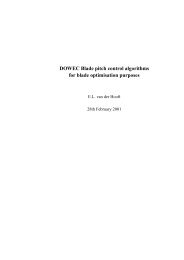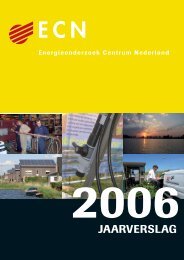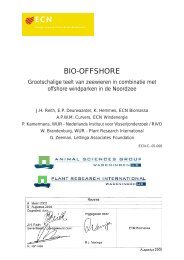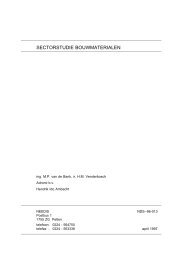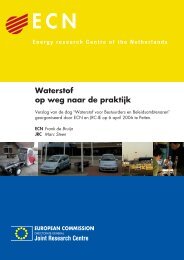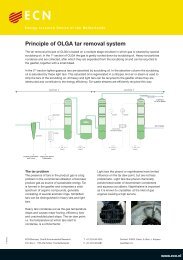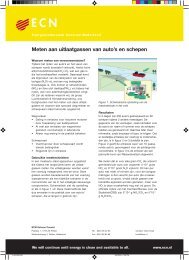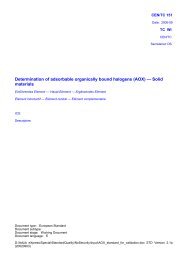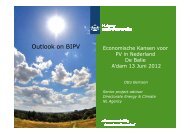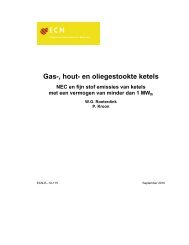PDF format (503 kB) - ECN
PDF format (503 kB) - ECN
PDF format (503 kB) - ECN
Create successful ePaper yourself
Turn your PDF publications into a flip-book with our unique Google optimized e-Paper software.
2050 2.9 EJ 42 2.5 EJ 37<br />
Table 7 shows the same effects as table 4. Because of the high occupancy of individual transport systems, the<br />
public systems score worse than the individual systems. Therefore, a higher reduction potential is achieved in<br />
the Market Drive scenario, in which a larger share of the transport demand is provided with individual transport<br />
systems, than in the Rational Perspective scenario with the high public transport share. Once again, it<br />
should be noted that this high occupancy of individual systems is more realistic in a system with a large public<br />
transport share.<br />
CO2 emissions related to passenger transport<br />
The total energy saving potential for passenger transport also depends on external factors. The ERE value for<br />
electricity is of great importance for the results. Next to that, improvement options in the manufacturing industry,<br />
as well as in the GER value of materials could contribute to energy savings associated with transport. The<br />
CO2 emissions of transport are closely related to the energy use for passenger transportation. As shown in figure<br />
4, the carbon content of a energy carrier determines the CO2 emission.<br />
Primary energy use<br />
of carrier i<br />
Figure 4. Calculation scheme of total CO2 emissions<br />
* =<br />
Carbon content<br />
of carrier i<br />
CO 2 emission<br />
of carrier i<br />
In order to achieve a 90% reduction in the CO2 emission, not only the energy use, but also the carbon content of<br />
the energy carriers should be taken into account. This extra factor also offers an extra opportunity to reduce the<br />
emissions.<br />
Along with the ERE value of electricity, the carbon associated share of electricity varies. When the share of non<br />
fossil fuels used for electricity increases, the ERE value for electricity decreases, and so is the associated carbon<br />
content. Next to the improvement options mentioned in this paper, also changes to other fuel mixes like biofuels<br />
or hydrogen are conceivable. This will not result in an energy reduction, but may result in a reduction of the<br />
CO2 emission, provided that the new fuels have more favourable carbon contents or are produced sustainably<br />
(with closed carbon cycle or out of electrolysis driven by photovoltaic electricity).<br />
Regarding the reduction of CO2 emissions it may be concluded that analogue to the energy consumption an<br />
80% reduction in 2050 is possible. With a change to other fuels this reduction percentage may be even higher.<br />
In order to achieve a 90% reduction in 2050, the external factors influencing the CO2 emissions should be<br />
halved.<br />
Discussion and conclusions<br />
The calculations in this paper show considerable energy saving potentials within the transportation system.<br />
With only technological options, a 50% reduction is possible in 2020, and a 60 % reduction in 2050. When<br />
non-technical options are added, requiring major behavioural adaptations, 80% reduction can be achieved in<br />
2050.<br />
Implementing the technological options will result in higher costs in the transportation sector, since the various<br />
options require extra research and production facilities. Partly, these extra costs will be compensated by the fuel<br />
savings achieved by the introduction of the new technology. In general, the first savings are the cheapest to realise,<br />
more expensive options will only be implemented if the cheapest options are already in use. With the<br />
subdivision made in this paper, this general decrease in costs is not so obvious. The options emphasising on<br />
behavioural change generally have lower costs per kilometre. Doubling the occupancy rate about halves the<br />
costs per passenger kilometre. So the implementation of the technological improvement options result in higher<br />
costs, whereas the more categories of options are implemented, the lower the costs of transport will be.



